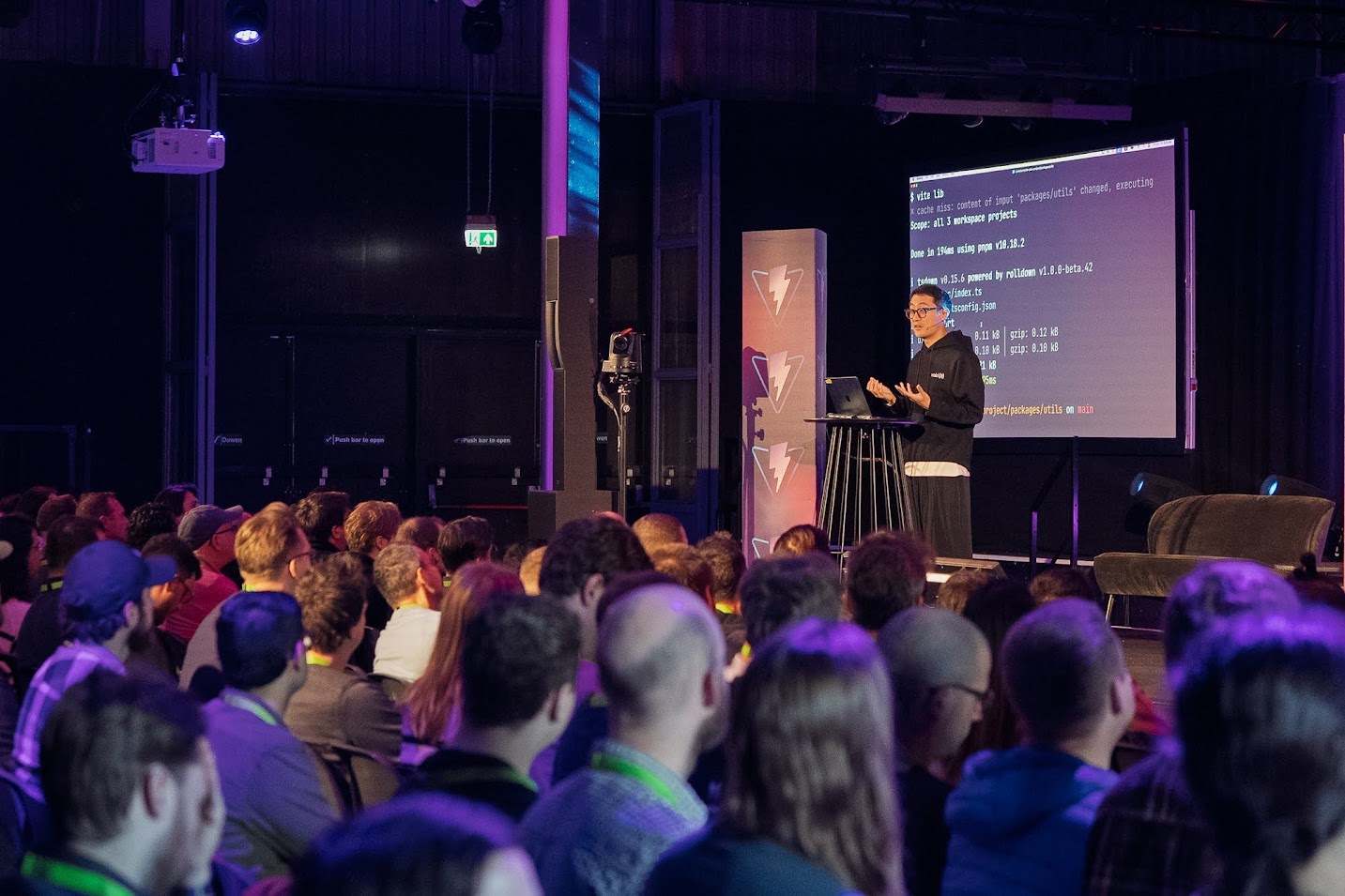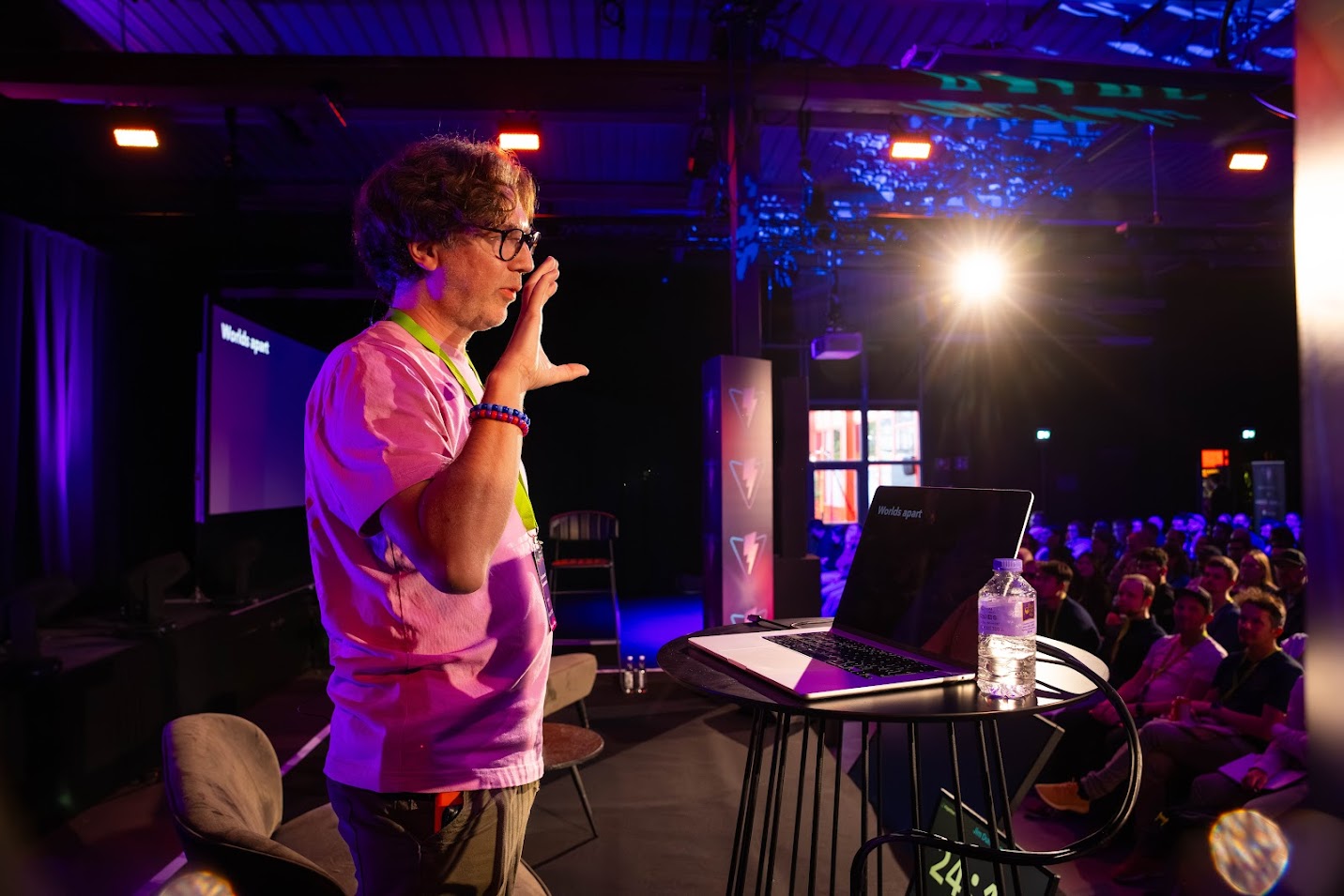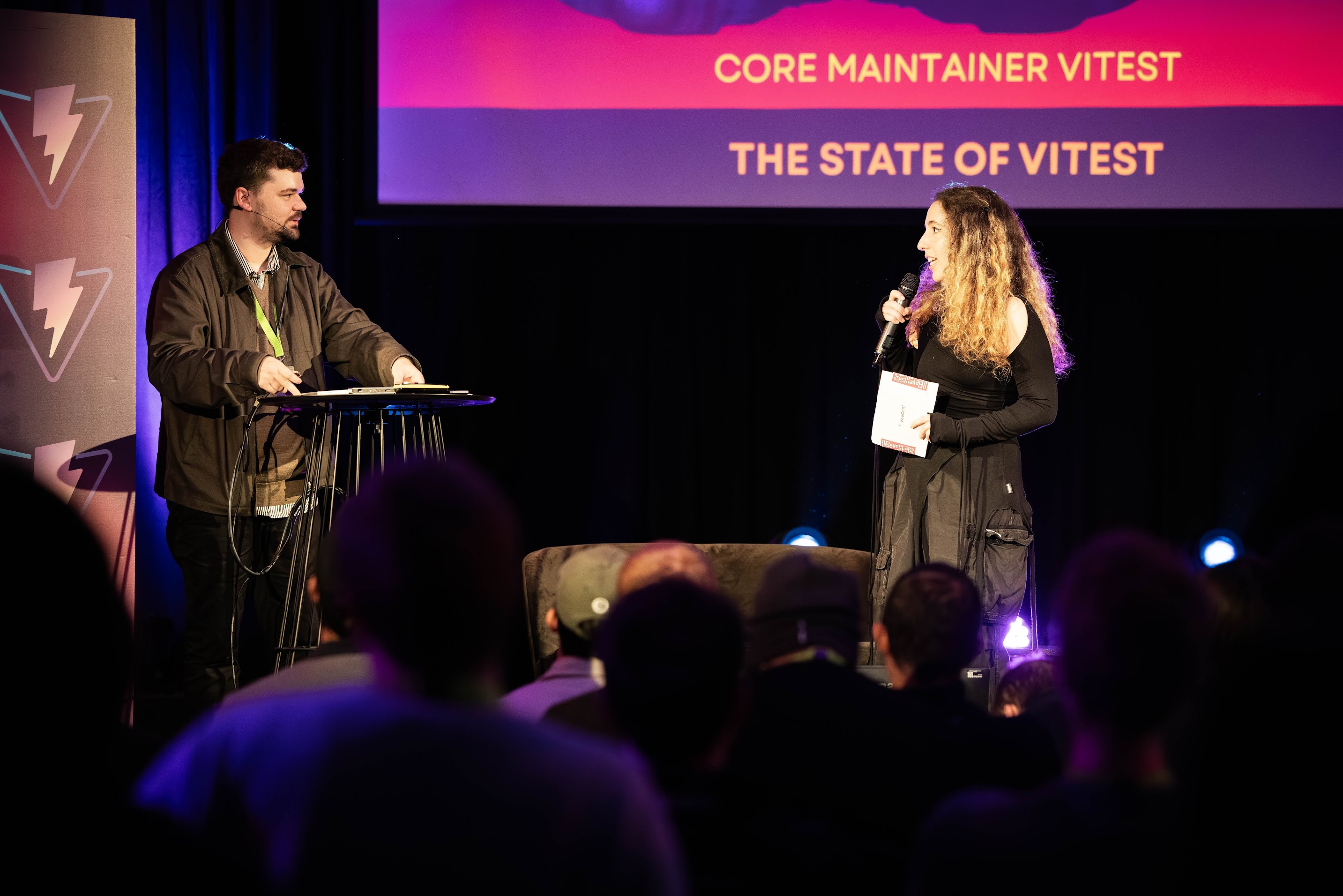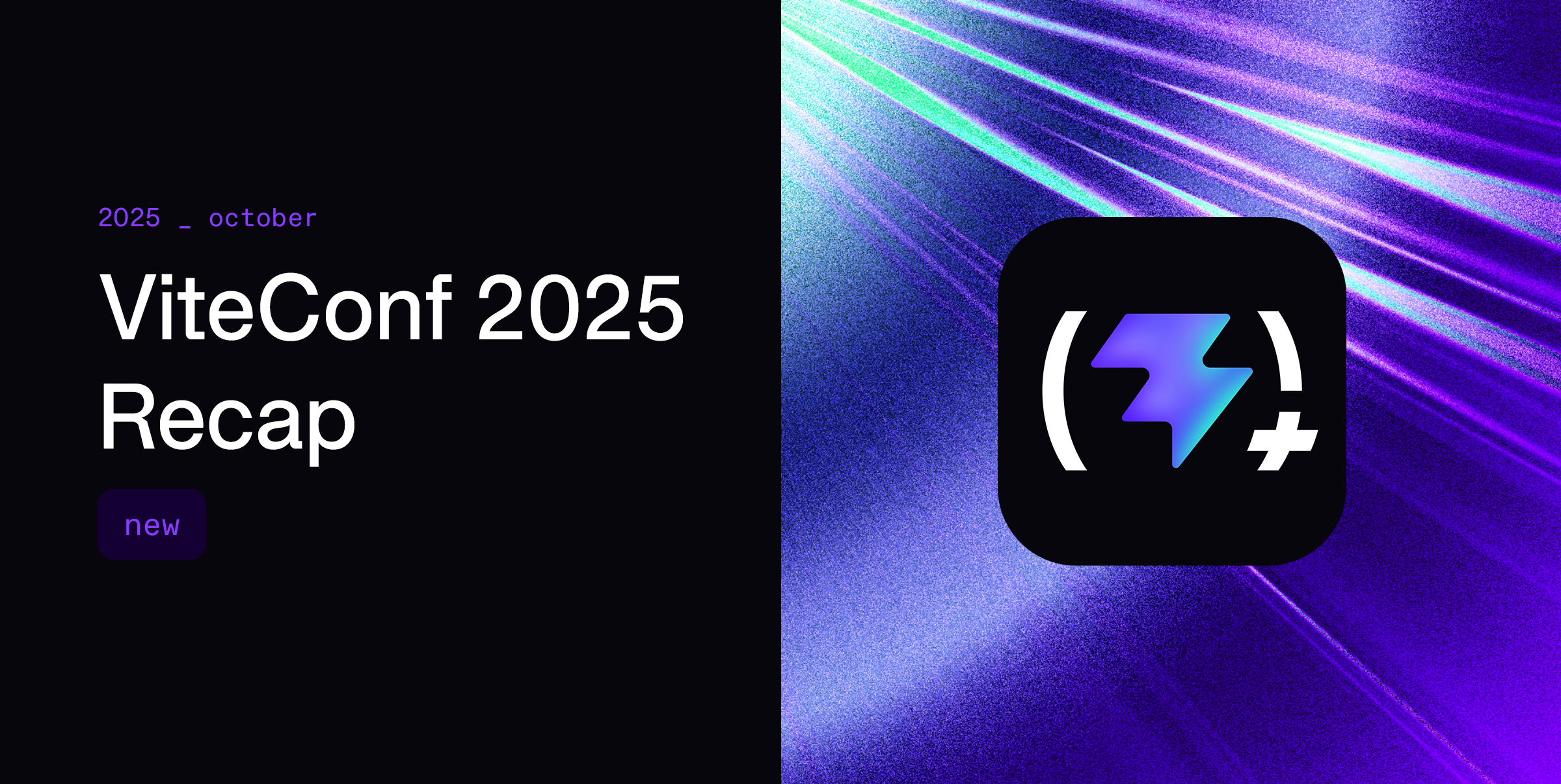/posts/whats-new-viteconf-2025.mdWelcome to a special edition of What’s new in ViteLand! Regularly, we recap the project updates for Vite, Vitest, Oxc, Rolldown and what’s happening in our community.

What happened at ViteConf 2025
ViteConf 2025 was truly special. For the first time ever, the community gathered in person in Amsterdam, bringing together framework developers, Vite maintainers, and enthusiasts from around the world.
Of course, ViteConf didn't pass without some major announcements, so here is a recap of the biggest news, brought to you by the VoidZero team.
PS: If you've missed it in person or didn't catch the live stream, take a look at the VODs in the ViteConf playlist.

✨ Meet Vite+: The Unified Toolchain
The biggest news from the keynote was the official unveiling of Vite+, a superset of Vite and command line interface that integrates a suite of essential developer tools into a single, cohesive experience with first-class monorepo support and built-in caching.
Vite+ extends the familiar vite CLI with new commands for testing, linting, formatting, library bundling, scaffolding and task running. It all works together out of the box with zero configuration and integrated caching.
Why it matters
Vite+ removes the need for a “tooling PhD.” By unifying all important parts to develop a production-ready application in one CLI, it dramatically simplifies project setup and reduces configuration overhead.
Teams gain a real productivity boost, while enterprises benefit from security, backed by clear SLAs and first-class caching. All without sacrificing Vite’s trademark speed and developer experience.
A standardized toolchain means better developer mobility and a shorter onboarding period for internal transfers.
- Read the Full Announcement Blog Post
- Explore the Vite+ Website
- Watch Evan's talk with a live demo of Vite+

⚡ Oxlint Supports JavaScript Plugins
Until now, Oxlint’s performance advantage came with a drawback: you had to continue running ESLint while using Oxlint. Even though more than 500 linting rules were rewritten in Rust, you couldn’t utilize your custom ESLint rules, or any of the rules that was not ported over yet.
Oxc Core Team member Jim Dummett presented at ViteConf what people were waiting for: Oxlint’s JavaScript Plugin support is now available.
This integration leverages the speed of the Rust-based linter while allowing the use of custom rules and extensions via an ESLint-compatible JavaScript API. Next steps are filling in the gaps of missing ESLint APIs and continuously improving performance.
Why it matters
Running JavaScript plugins in Oxlint unlocks the ability to use many of the existing 280,000 ESLint plugins on npm, as well as custom rules, without friction, while still benefiting from Oxc’s blazing-fast performance. Together with true type-aware linting, Oxlint is becoming a full replacement for ESLint: Thanks to its performance, features, and extensibility.

💻 A Sneak Peek at Vite DevTools
When building applications, developers must be able to inspect the build process to understand how different parts of their codebase and dependencies interact. To make this easier, Anthony Fu presents the new Vite DevTools at ViteConf, which include:
- A visual build analysis tool UI. It presents an overview over files used for bundling your application, which Vite plugins being used, and much more.
- The Vite DevTools plugin API. Framework and library authors, as well as users will be able to add their own extensions to Vite DevTools. This will allow customization tailored to the user’s tech stack.
Why it matters
Vite DevTools will give you insights that were hard to retrieve before, such as which plugins are slowing your build down, how different Vite plugins transform your code, why your code is split up differently in the final bundle and how the different files are related to each other.
Less time spend on debugging, more time spent shipping features
In addition to in-depth analysis of your application’s build step, you will get framework- and library-specific DevTools integrations, thanks to the DevTools plugin API and can even build your own extensions to meet your needs.

🌐 Full-stack Vite Apps with Nitro v3
If you’ve ever built a frontend app with Vite and then realized you need a backend for things like databases, user accounts, or you wanted to add server-side rendering (SSR), you know it can get complicated. Until now, you typically had three options:
- Go all-in on a meta-framework,
- manage a completely separate backend service,
- or work your way to get your own manual SSR setup.
Each path added complexity, forcing you to manage two different projects, deal with separate deployments, or a lot of manual plumbing and knowledge.
With Nitro v3, this changes now! The next-gen server toolkit can turn your application into a true full-stack application with minimal friction. The best part? Nitro now comes as a Vite plugin.
The creator, Pooya Parsa, shows how you can define API routes, easily set up SSR, and utilize serverless features with zero configuration. And thanks to Nitro, developers can deploy their entire Vite application to any platform, including Cloudflare Workers or Netlify.
Why it matters
You finally get the benefits of SSR and API routes while eliminating the complexity of managing and deploying separate backend services.
You can stick to your familiar, fast Vite environment and workflows for the whole stack, without opting into more features than you’d be interested in. All, while being able to deploy your application universally.

✅ Vitest 4: No more Simulated DOM
Vitest’s journey was a major highlight at ViteConf, with lead maintainer Vladimir Sheremet outlining the existing State of Vitest and its path for the future. With the recent release, Vitest 4.0 delivers a stable Browser Mode, covered by Jessica Sachs’ talk at ViteConf. In turn, you can replace simulation DOM libraries like JSDOM or happy-dom with an actual browser, all without changing the actual test code. Among other features, support for Visual Regression Testing has been added. Vitest can now capture screenshots of your UI components, then compare them against reference images to detect unintended visual changes.
Why it matters
Browser Mode changes how you test UI components, giving you significantly higher confidence that your code will work for real users due to using a real browser. You no longer have to chase down subtle inconsistencies between your DOM library and actual browser behavior. With the new Visual Regression Testing functionality, you’ll have a safety net for your UI, automatically catching these unwanted visual changes before they reach production.
- Watch Vladimir’s talk on the State of Vitest
- Watch Jessica’s talk about the Browser Mode
- Read our Vitest 4 announcement

🚀 Ship Better Products Faster
As applications grow in complexity, engineering teams begin hitting walls: development slows down, CI builds drag on, and product performance suffers. VoidZero provides the tooling to help teams break through, enabling them to ship better products, faster.
Better products. Product speed is critical to user experience. For Framer, migrating to VoidZero’s Rolldown delivered a major speed improvement. By simply optimizing their configuration, they cut the Largest Contentful Paint (LCP) for large sites by up to 41%, all without touching application code. Rolldown now powers over 200,000 pages built with Framer, boosting the end-user experience.
Faster. Taking an action and immediately observing the effect is key to experimentation. A fast feedback loop to iterate on. Imagine trying to find which switch turns on a light but there's a 3 minute delay. Swap turning on a light with linting and that’s what Linear’s engineers experienced. It took 3 minutes to locally lint Linear’s codebase. The exact opposite of a fast feedback loop. That’s why Linear adopted VoidZero’s Oxlint, which reduced linting times 90%, along with Rolldown-Vite and Vitest. Fast tools matter for developer experience and developer velocity.
Why it matters
Companies like Framer and Linear are known for being fast. Their products are snappy and create delightful user experiences. Under the hood, they rely on equally fast tooling. VoidZero's products have a meaningful impact on developer velocity and the end-user experience.
Thank you to everyone who joined us in Amsterdam, watched the live streams or the VODs on YouTube!
The VoidZero Team
CallToAction.vue